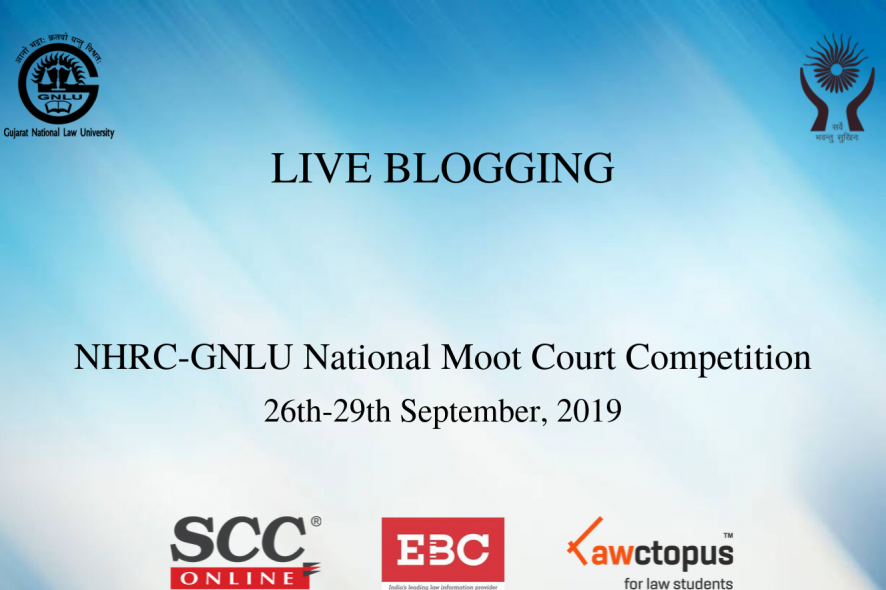GNLU brings to you the NHRC-GNLU National Moot Court Competition. In keeping with the tradition, the media team will provide you with updates in real time about moot related developments.
This edition has a whopping 76 teams battling it out over three days for exciting prizes.
Registrations begin at 4:30 p.m. on 26th September, with the competition unfolding over the three following days, culminating in finals on 29th September, 2019. We will bring you exclusive, live updates beginning with the opening ceremony. Don’t forget to follow us on Facebook as well!
Stay tuned for more!
Day 1: 26th September 2019
Registration
17:21 The teams have started arriving at the Orientation Hall where we are getting ready for the registration process!
17:25 With the excitement flooding in, the registration has finally started. The participants are being given their respective folders and schedules.

17:49 The crowd is buzzing with excitement as they go through their folders ,planning their next move for the upcoming rounds starting tomorrow!
17:54 Meanwhile, lets take a look at the prizes up for grabs!
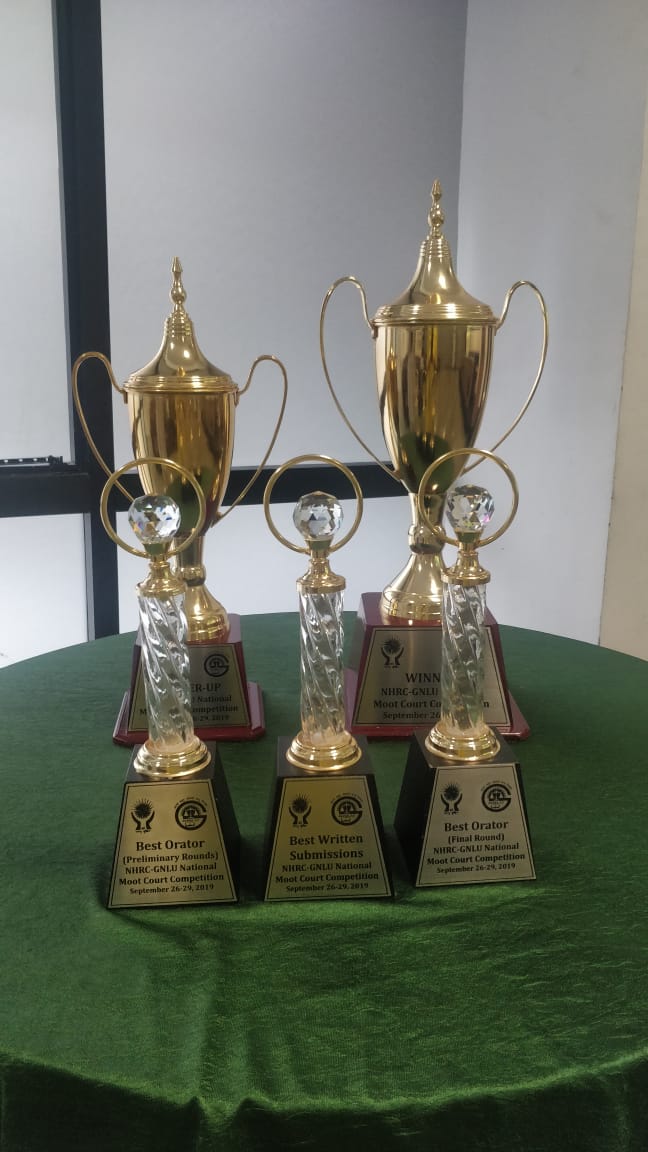
18:03 Receiving the memorials of the other side has sparked up a new enthusiasm in the room. Participants ruffle pages quickly to see what they are up against tomorrow!
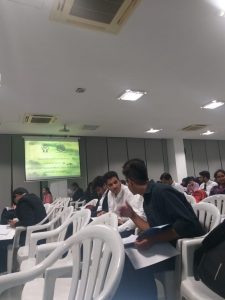
18:22 Dignitaries are on the dias, and we are ready to begin. Some of the biggest names in human rights are here, and shall be giving addresses, including our chief guest, Justice N.V. Anjaria (Judge, Gujarat High Court), Mr. Jaideep Govind (General Secretary, NHRC), and Jaimini Kumar Srivastava (Deputy Director, Media and Communication)
18:28 Dr. Shanthakumar, our Director extends a warm welcome to all our participants. He thanks NHRC for collaborating with GNLU, for providing students with a platform to moot in human rights law. He states that GNLU is well known for its hospitality and hopes that participants have a pleasant stay here.
18:35 Mr. Jaideep Govind, the General Secretary of NHRC, delivers the keynote address. He states that the greatness of humanity is not in being human but in being humane. He speaks about the relevance of moot courts for law students. They enable students to think analogically, and become better at argumentation. He also goes on to appreciate the high number of participation garnered by the moot in this edition.

18:38 Mr. Govind also reflects on the work of the NHRC in combating human rights abuses in terms of custodial violence, rape, and so on. He quotes Rabindranath Tagore, saying that the highest form of education is the one which allows us to live in harmony with others. He draws inspiration from the lines of Nelson Mandela and states that denying human rights to anyone amounts to denying them humanity.
18:45 Justice N.V. Anjaria now shares his thoughts on the subject of the moot problem. He gives an international perspective on the subject of citizenship, and how statelessness is being created across the globe, as more and more people are forced out of their countries. He emphasizes on the universal nature of human rights, and how they exceed beyond national boundaries. They are also independent and interrelated.

18:50 He speaks about the conflict of interest that states face as they must restrict their citizenship rights owing to the implications that citizenship rights have for local governments. At the same time, states also have a responsibility to restrict statelessness. This conflict is reflected in the moot problem
18:54 Dr. Jagadeesh Chandra now delivers the vote of thanks. He thanks everyone who contributed in making this event a success. He also thanks the participants who have made the moot a grand success.

19:00 The participants are oriented about the rules of the competition and the scoring procedure .

19:10 With the inaugural ceremony coming to an end, the participants proceed for dinner.
Day 2: 27th September
09:45 The day commences with the first set of preliminary rounds. Teams will now present the arguments which they have been preparing for months. Time to put their legal knowledge to the test!
11:45 The rounds today are both heated and enjoyable. Each time is putting their best foot forward, wanting to be a part of the Top Eight who proceed to the Quarter Finals.
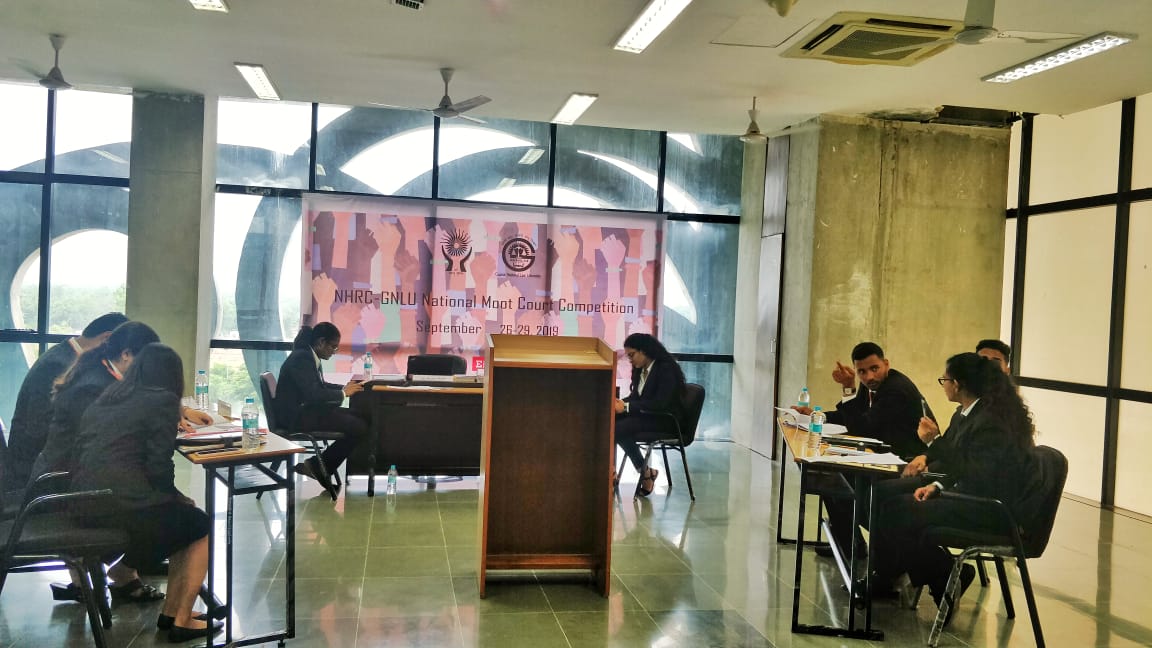
18:05 We are almost drawing to the close of the first day of preliminary rounds. The last few teams wait in the waiting room for their turn to argue.
Day 3: 28th September
11:40 The second set of preliminary rounds have begun. Participants rush through their arguments, jotting down the most important and indispensable points right before their rounds.
16:30 As the day moves ahead, excitement has not reduced. Judges are grilling participants in courtrooms, and there is enthusiasm to perform well in the air!
19:15 The last rounds for the day have concluded. These two days were filled with immense learning, and the same could not have been possible without the assistance of our participants. We are thankful that they have come to GNLU from all across India to showcase their talents. Now, our director, Prof. S. Shanthakumar congratulates this effort by awarding them with participation certificates.
20:40 As we draw closer to the announcement of results, the participants wait eagerly to find out if months of hard work has finally borne fruit.
21:26 The moment that we have all been waiting for is finally here! The qualifying teams for tomorrow’s quarter-finals have been announced. The following teams(in alphabetical order) proceed to the quarter-finals tomorrow:
Dr. Ram Manohar Lohiya National Law University
Guru Gobind Singh Indraprastha University
National University of Advanced Legal Studies
Renaissance Law College
SASTRA University School of Law
School of Excellence in Law, Tamil Nadu Dr. Ambedkar Law University
School of Law, Christ University
Tamil Nadu National Law University
We congratulate the Top 8! Tomorrow shall be a very crucial day for the qualifying teams as we advance into the quarter finals followed by the Semis and Finals! Stay tuned for all the updates!
Day 3: 29th September
Today is the day when teams shall battle it out in the Quarters, Semis and Finals. This day shall determine who shall be adjudged the winner of this moot!
QUARTER-FINAL ROUNDS
09:40 Our Quarter-Final Rounds are underway! This is an exciting time for participants, as they present their arguments before prestigious judges, and are tested on their abilities.

11:00 We are almost coming to the end of the Quarter-Final Rounds. As the judges hear the rebuttals, participants try their best to present the finest points of their research to impress the judges.

11:30 The qualifying teams for semi-finals have been announced. The following teams(in alphabetical order) proceed to the semi-finals:
Dr. Ram Manohar Lohiya National Law University
National University of Advanced Legal Studies
SASTRA University School of Law
Tamil Nadu National Law University
We congratulate the Top 4!
Semi-Finals
Now, we move on to the semi final rounds of the competition! There are two courtrooms, and four judges, and we bring to you live updates from each courtroom!
12:20 (CR1) The Judges have entered the courtroom and we are ready for a mindblowing round. Speaker 1 from the Petitioner has started speaking. She lays down the structure of her argument in a brief and concise manner. The Judges here are Mr. Rishabh Sancheti (Advocate, Supreme Court of India) and Jayshree Satpute (Independent Law Practitioner & Co-Founder, Nazdeek)
12:22 (CR2) The Courtroom is set, and the teams are ready. Judges enter, and the first speaker seeks permission to approach the podium. The Judges in this Courtroom are Ms. Amrita Paul (Programme Officer, Commonwealth Human Rights Initiative) and Ms. Aprajita Rana (Partner, AZB & Partners)
12:25 (CR1) The judge questions the speaker about a case law that the Speaker cited in her contentions.
The Speaker has a tough time relating her case laws with the facts of the case and the bench keeps grilling her for the same.
12:35 (CR2) The Speaker is appealing to the emotional side of the problem, arguing with great conviction, as the bench listens intently.

12:37 (CR1) The Speaker conceded to the Bench’s rigorous questioning. Mr. Rishabh asks how can the Speaker back her arguments with case laws when she does not know the underlying facts behind them?
12:38 (CR2) The Speaker has ran out of time, but he seems to have a plan. He quickly summarizes his arguments, as if he had anticipated this, and yields the floor to his co-speaker.
12:34 (CR1) The Bench poses a bunch of questions about the facts of the problem. After all, clarity on facts is the most important.
12:48 (CR1) The Bench points out the contradictions in the arguments of the speaker, and points out the loopholes in the law.
12:40 (CR2) The second speaker lays down his structure. One question asking him to repeat his argument opens a chance for him to show his preparedness and he backs his claim with a case.
12:42 (CR1) Having exhausted her time limit, she seeks an extension of 2 minutes. The Bench gives an opportunity to summarise her portion of the argument.
12:43 (CR1) The second Speaker from the Petitioner has started speaking. The Bench seeks a clarification regarding an argument put forth by the first speaker.
12:44 (CR2) The Bench is now grilling the participants which multiple questions. The Speaker maintains his calm, and does not fluster easily in light of this functioning. The Bench asks the Speaker to refer to the facts for his argument.
12:46 (CR2) There is intense back and forth questioning. The Judges keep seeking clarifications from the speaker about his argument. But, he appears to be both articulate and clear.
12:50 (CR1) Ms. Jayshree does not seem to be satisfied by the Speaker’s contentions. Then the Speaker tries citing her Co-Counsel’s arguments when Mr. Rishabh quips that she should rather cite the law than her Co-Counsel.

12:53 (CR2) The Bench asks the speaker to rely on statistics and evidence to prove his arguments. The Speaker directs them to the moot problem, however, the judges do not seem convinced.
12:57 (CR1) The Bench puts in relevant historical events to point out the loopholes in the argument. Mr. Rishabh asks the Speaker to use facts legally, not emotionally.
13:00 (CR2) There is some confusion with regard to a particular provision between the bench and the Speaker. However, the Bench asks the speaker to explain the same later, and move on to the fifth and final issue.
13:00 (CR1) With the Speaker exhausting her allotted time limit, she seeks an extension and is granted an additional minute.
13:03 (CR2) The Speaker is now wrapping up his arguments. He places forth his contentions, and Ms. Amrita Paul questions one of his demands. She asks the speaker to explain how a case used by him will apply.
13:03 (CR1) The Speaker from the Respondent side has commenced speaking. He briefly lays down a concise structure of his arguments
13:05 (CR2) The Respondent Speaker now begins her argument. She explains her first issue, and Ms. Amrita Paul instantly asks her a question, but she does not get baffled.
13:10 (CR1) Mr. Rishabh points out that the Speaker lacks factual clarity based on his interpretation. However, the Speaker makes good come back withe the help of a case law and the Mr. Rishabh seems impressed
13:12 (CR1) The Bench is highly upset with the Speaker’s interpretation of facts. Now, they demand a legal backing for all his contentions
13:13 (CR2) The Respondent is now relying on a case to prove her point. She has a print ready, and passes the same to the judges, as she proceeds with her argument.
13:19 (CR2) The Judges grant the speaker as extension in time, as they continue their questioning. She has some help though, as her teammates provide her with useful chits to answer. Once this answer is done, her arguments come to an end. She calls upon her co-speaker to continue with the arguments.
13:22 (CR2) The second speaker is off to a good start, she highlights several important cases for her issue, and lays down her arguments.
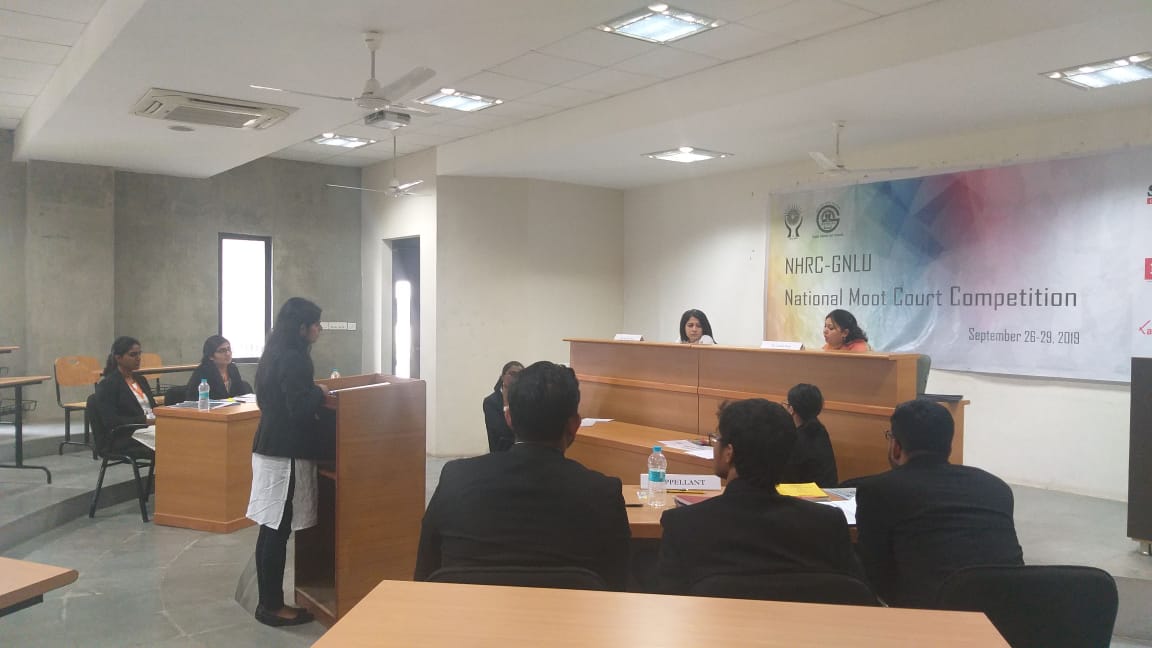
13:26 (CR1) The Speaker is granted an extra minute to complete his contentions. Thereafter, the second speaker takes over. The second speaker from the Respondents side speaking. She divides her contentions in two parts. The Bench enter into rigorous debate and discussion on what points of law that she is contesting.
13:29 (CR1) Subsequent to this, Mr. Rishabh points out a contradiction in her Co-Counsel’s argument and wants her to address that first.
13:32 (CR2) The Speaker is in a full flow now. The Judges listen to her intently as she continues her arguments. At the same time, the Petitioners are ruffling around their desk, preparing their points for rebuttals.
13:34 (CR2) The Bench suddenly asks the Speaker an unexpected question. The Speaker takes a few seconds to understand the question, and then continues with the answer. She takes a moment to structure her answer.
13:36 (CR1) The Speaker is putting in all efforts to substantiate her arguments amidst a rapid round of questioning.
13:37 (CR2) Ms. Amrita Paul questions the speaker on what her argument means, and places her own understanding before the speaker. The speaker humbly disagrees from her interpretation, and explains her argument and how it differs.
13:40 (CR1) Mr. Rishabh is repeatedly pointing out contradictions in her Co-Counsels arguments.
13:41 (CR2) It is time for rebuttals! The petitioners have 6 questions to raise before the respondent. The rebuttals are structured and concise, and the respondents are quickly jotting them down.
13:42 (CR2) The respondents now begin their reply to the rebuttals. They are quick to clarify their arguments, and do so in a manner as structured as the way in which they were raised.
13:49 (CR1) Its time for Rebuttals and the Speaker from Petitioners side puts forth 4 points. The Respondents answer, justifying their stand.
This marks the end of the Semi-Final Rounds. Now, we wait for the results to be declared, and for the top two teams to be announced.
FINALS
We now announce the two teams who have made it to the finals! The qualifying teams (in alphabetical order) are:
Dr. Ram Manohar Lohiya National Law University
National University of Advanced Legal Studies
We wish them good luck and look forward to an exhilarating final round!
The judges for the final rounds are as follows:
Ms. Jyotika Kalra, Member, National Human Rights Commission
Ms. Manisha Lavkumar Shah, Senior Advocate, High Court of Gujarat
Mr. Murali Neelakantan, Principal, amicus
Dr. Nasreen Chowdhory, Assistant Professor, Department of Political Science, University of Delhi
Dr. Srinivas Burra, Assistant Professor, South Asian University
Appellants
15:16 The petitioners begin their arguments. The first issue raised is regarding maintainability. The speaker states that the SWIPA seeks to protect the interest of the indigenous people of Aurom and therefore, can bring this petition. The judges seem convinced and ask him to move to his next argument
15:18 The next argument raised is with regard to the challenge to Section 6A of the Omberlands Citizenship Act. Mr. Murali asks the speaker to explain exactly what part of Section 6A is being challenged. The speaker states that his argument is based on Article 14 and Article 355 of the Constitution.
15:21 The Speaker argues that the Section is not found on a rational basis and therefore, it violates of Article 14. He is heavily questioned about what the purpose of the Amendment is. He states that granting citizenship to illegal immigrants is being challenged. On being asked by what is to be done then, the Speaker states that there must be a mechanism to recognize immigrants, and to report the same to the Mumbarian authorities.
15:26 The Speaker states that granting citizenship to illegal immigrants legitimizes their residence in the state. He argues that there is a right given to citizens under Article 19 to reside wherever they wish. Mr. Murali further questions the speaker on the difference between residence and citizenship.
15:29 The Speaker now discusses Article 29 of the Constitution and how the illegal immigrants have degraded the culture of the indigenous population. Mr. Murali then questions how the their rights have been violated.
15:32 Ms. Jyotika inquires about the statistics pre and post 1990. Mr. Murali then further asks about some authority that defines the term “minority”.
15:35 The Speaker now moves to his argument regarding the agreement with Auro Youth. The Speaker states that an amendment based on an agreement with a private party violates principles of constitutional morality. As the Speaker is faced with the weighted question of defining constitutional morality, he runs out of time.
15:37 The Second Speaker from the Petitioner’s side has commenced speaking and begins his argument related to Section 3 of the Omberlands Citizenship Act. He starts by explaining two practical situations which could arise under the Act which would be unconstitutional. One situation is how an entire generation of illegal immigrants could be created by allowing citizenship by birth in these cases. This would violate Section 355 of the Constitution. He also points that the country of Omberlands is an economically rich country and immigrants from third world countries enter their country to secure rights for them and their children.
15:40 Mr. Murali seeks clarification as to what exactly must be “read down”.
15:41 The Speaker explains that he wishes to restrict the interpretation of Section 3. Dr. Nasreen asks the speaker a question regarding the term ‘illegal immigrants’. However, the speaker seems to not understand it, and he is asked to move on.
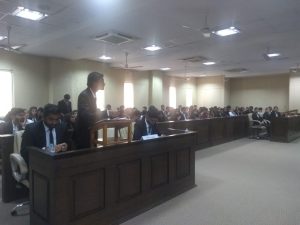
15:46 Mr. Murali asks where the circumvention occurs here. The Speaker states that here, an illegal immigrant can circumvent the law by having a child in the State, and will be able to procure a Visa, and subsequently acquire rights of citizenship.
15:49 Dr. Nasreen asks the speaker how many groups have been designated as refugees. The Speaker is unaware, and Dr. Nasreen asks him to do his homework better. The Speaker makes a distinction between immigrants and refugees, and states that immigrants amount to a burden on the State, while refugees are protected within the State.
15:51 Mr. Murali grills the participant by asking him how a refugee status is granted, and which department of the government gives the status of a refugee. Dr. Nasreen and Mr. Murali draw a parallel in this present case between Tibetian Refugees and the Mumbarian People involved here. The Speaker states that the distinction here lies in the fact that there is no well-founded fear of persecution in this case.
15:56 The Speaker is asked whether the subject matter of this dispute is that of a civil suit under Article 131 or under a public interest litigation. Mr. Murali states that the people are not the parties to the agreement, which is why this cannot be the subject of a PIL.
15:58 The Speaker now argues on Article 299 upon which Mr. Murali poses questions on the Rules of Business of the Central Government.
Respondents
16:02 The first speaker from the Respondents’ side begins her contentions and lays down a brief structure of her arguments. She states the Rabindranath Ghose case to substantiate her arguments. Mr Murali points out that it is a service matter case, does not specifically relate to fundamental rights.
16:06 She further contends that there was no violation of the fundamental rights. Mr. Murali points that in various countries people can reside but they are not granted citizenship. She points out underlying facts that compelled the government to grant citizenship.
16:11 The Speaker then puts forth her contentions in relation to the cut off date. Mr. Murali points out that they are violating international customs by setting a cut-off date. To this, she replies that the purpose of having a cut-off date is to bring out a distinction between those who have been persecuted and those who enter for economic reasons.
16:16 Dr. Nasreen asks whether the Right to Life apply to illegal immigrants. She evades this question and continues her argument stating that there will be no right under Article 21 for persons who enter the country illegally. She states that Article 21 does not apply to people who enter the state illegally. She claims to have case law to support this point, however does not have anything to give to the judges when they ask for the same
16:25 The Speaker after finishing her contentions invites her Co-Counsel to put forth further submissions.
16:27 There is constitutionality of Section, contends the speaker. She contends that not everybody is granted citizenship but those children whose either parents are citizens and it is a birth right of every child to live in his/her parents country.
16:31 Mr. Murali asks whether the Speaker is contending that she wants to render children ‘stateless’.
16:32 The Bench wants to know what should be done about a child whose both parents are illegal immigrants. Further, Dr. Nasreen wants her to define the term “stateless.” The speaker relies on the Convention on Stateless Persons to answer the query.
16:38 Mr. Murali suggest rather than reading down the provision, they can strike out the cut-off date.
16:41 The Speaker requests that she be allowed to proceed to further submissions due to paucity of time.
16:47 The Speaker states that the agreement was not entered into in the name of President, rather by the Prime Minister which is why it would not be binding. Mr. Murali states that the facts of the problem are silent on this point. Further it is stated that the agreement is merely an agreement to negotiate, and it is not binding. After her completing her contentions, she moves to the prayer.
16:50 The petitioners now raise their rebuttals. Their rebuttal extend to whether the inability to depart migrants from Mumbaria was the reason to enact Section 6A, regarding the practical application of Section 6A, and the duty of the state to take welfare measures under Section 355 of the Constitution.
16:52 The Respondents reply stating that the very reason that amendments were enacted to the Citizenship Act was to fulfill the duty of the government under Article 355. Further, she also explains that the cut off date was enacted to ensure the protection of citizens under the Act.
VALEDICTORY CEREMONY
All the teams have gathered in the Orientation Hall, waiting anxiously for the results.
The dais today is honored with the presence of Mr. M.H. Shah, Hon’ble Acting Chairperson, Gujarat State Human Rights Commission, Ms. Jyotika Kalra, Member, National Human Rights Commission, Dr. Sanjay Dubey, Director (Administration and Policy Research), National Human Rights Commission along with Honorable Director of GNLU, Dr. Prof. Shantha Kumar.
17:34 The Student Conveners of the OC Ms. Yashi Saraswat and Mr. Rohan Merchant thank NHRC for associating with GNLU and providing an opportunity to organise such a prestigious moot.
17:37 Our Honorable Director addresses the gathering. He mentions that this has to be udoubtedly one of the most successful moots of the country as 98 had registered and 76 came for the competition. He expresses his gratitude to NHRC for the support that it rendered to organise the competition. Finally, he concludes by saying that the moot court competitions provide an excellent opportunity to teams to socialise, forge new friendships and strengthen old ones,
17:41 Mr. Shah addresses the gathering and remembers that time when the campus was being constructed during his tenure as the legal secretary. He along with others ensured that a good campus was created and now he is assured that his efforts were a success. He puts forth his view on the issue of illegal immigrants and concludes by expressing his gratitude to one and all for the successful organization of the moot court competition.
17:46 Ms. Jyotika addresses the gathering and says she is pleased to be a part of the moot court competition. She showers appreciation on the participants and their mooting skills. Addressing the issue of illegal immigration, she also explains that the culture and rights of the local population will always get affected by the influx of masses of people. People from outside are bound to come and settle and that the law of nature.She concludes by saying that this should not be feared but it should be welcomed and encouraged for it helps in creating a global family.
17:55 Dr. Ram Manohar Lohiya National Law University and National University of Advanced Legal Studied battled it out in the finals today. The winner is Dr. Ram Manohar Lohiya National Law University.
The detailed results are:
| Title | Team Code | Prizes |
| Winners | 192
Dr. Ram Manohar Lohiya National Law University |
Trophy
Rs. 50,000 cash prize Merit Certificates |
| Runners Up | 184
National University of Advanced Legal Studies |
Trophy
Rs. 25,000 cash prize Trophy Rs. 25,000 cash prize
|
| Best Written Submission | Chanakya National Law University | Trophy + INR 10,000 |
| Best Orator, Finals | Anand Kumar, National University of Advanced Legal Stuides | Trophy + INR 5,000 |
| Best Orator, Prelims | Pranika Misra, Dr. Ram Manohar Lohiya National Law University | Trophy + INR 5,000 |
| Semi-Finalists | Tamil Nadu National Law University
SASTRA University |
Merit Certificates |
| Quarter-Finalists | School of Excellence in Law, Tamil Nadu Dr. Ambedkar Law University
Renaissance Law College
Christ University, School of Law
Guru Gobind Singh Indraprastha University |
Merit Certificates |
18:04 Ms. Yashi Saraswat and Mr. Rohan Merchant express their heartfelt gratitude to all their co-coordinators and fellow OC members.
18:06 Vote of Thanks was delivered by Ms. Garima Goswami, the Facult Co-convenor.
With this, NHRC-GNLU National Moot Court Competition, 2019 officially comes to a close.This is the live blog team signing off!


